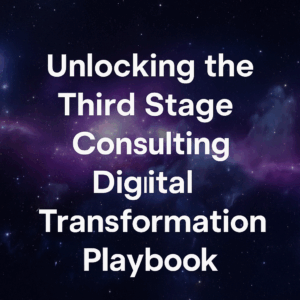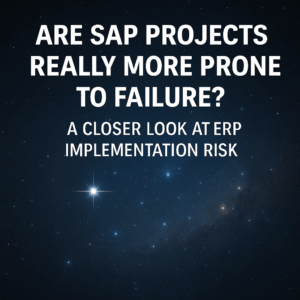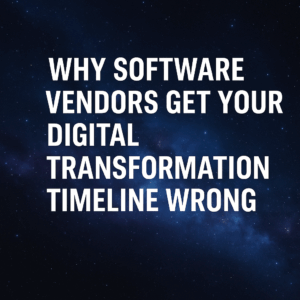When embarking on digital transformations, most organizations have a vision of innovation, but they get lost somewhere along the way. In this blog, I want to talk about how to incorporate innovation into your digital transformation.
Most organizations have a grand, big vision of creating more innovation within their organizations as part of their digital transformation. What often ends up happening is that companies get tripped up on just the basic technology upgrades and they never reach that intended future state or becoming more effective and successful.
To set the context, the first thing to think about is the difference between core automation and true innovation. This is where a lot of companies get confused and they think that they’re doing something very innovative, but they’re actually just automating the processes that they already have in place. Rather than looking outside their current way of doing things, they end up implementing technology that basically helps them do broken processes faster, or more effectively than they might have in the past.
In the end, the processes are still fundamentally broken. The first step of what I want to cover here is how can we shift our mindset from core automation to true digital innovation.
Table of Contents
ToggleInternal Innovation
Internal innovation typically focuses on the core of your business. Your financials, accounting, inventory management, human capital management, and sales processes are good places to start. Innovation grows from a strong foundation.
It is important to focus on core automation, but you don’t want to stop there. These automations should be as effective and efficient as possible so that you have time, resources, budget, and patience to get to the point where we actually get to digital innovation.
When you think about core automation, you don’t necessarily need to just focus on automating the way you’ve always done things. There are ways to be innovative even with your core when it comes to a business process as basic as your period-end close. This an example of an area where you can leverage machine learning to automate your processes. By leveraging this groundbreaking technology you can shift from being a highly manual process to more of an automated process so that you can free up resources to focus on more strategic aspects of finance.

It is important to be looking for ways that you can leverage technologies to automate your core. You can be innovative in your core, as well as ERP, financial and CRM, and human capital management types of systems.
Another example of core innovation would be on the human capital management side. One common source of innovation is this whole concept of Employee Self Service. Rather than just automating the old way of providing forms, benefits, vacation requests, performance reviews, etc. – see it as an opportunity for you to create an employee portal and a self-service model. By automating these manual processes you inspire innovation within something as simple as HR or HCM. These are just a couple of examples of ways you can be thinking about how to automate your core.
External Innovation
Now, where the real game-changing innovation comes into play is when you look externally such as customer and product-facing business processes. For example, anything that’s customer-facing is a great opportunity to look for opportunities to innovate and to make your organization stickier with your customers or potential customers. You then have CRM capabilities, and technologies you could be used to help automate the processes that you use to engage with your customers.
You may also have technologies like ServiceNow, or Qualtrics, which are two customer experience types of products that can help you provide better information to your customers. They also capture information from your customers and automate those workflows. Essentially, these are areas where you can really provide that true innovation.
If you are a manufacturing or an engineering-based organization, product lifecycle management types of technologies can help you automate those processes and provide better visibility into your product design, estimated lead times, and things of that nature. If you’re a manufacturing organization, even some of the manufacturing technologies and warehouse management technologies can help you provide innovation and better information to your customers, which then ultimately leads to superior service.

We want to consider not just what you can automate what we’re already doing today, but instead, how can we truly transform our business, processes, and technologies to reach the next level.
Business Model Innovation
Beyond internal and external innovation, now we can look at the business model. This is where you can get really creative and think outside the box of what you’ve done up until now. You have past experience, but now you can learn from that and create an updated, more in-depth model. There are a lot of examples you could be looking at, in the pandemic world that we’re living in now.
Post pandemic, a lot of organizations were forced to innovate and change the way that they operate, bring change to their business models. Something as simple as a local restaurant that suddenly can’t serve as customers inside their four walls. They had to figure out a way to create takeout, delivery, and other sorts of ways to reach their customers.
These restaurants had to recreate their websites, e-commerce, which led to a business model change. It is truly a matter of thinking more opportunistically, hopefully in less of a crisis mode, about how we can totally transform our model, service our customers better, and ultimately be more efficient and effective in the ways that we leverage technology and business processes.

Innovation Culture
The secret sauce to making this whole innovation thing happen is not necessarily just in your business processes, but deeply ingrained in the culture that you create. Looking at your digital innovation, from the perspective of how we can create a culture of digital innovation, not just technology and processes. It stems from changing the mindset of the way we think. It is important to get people to think outside the little silos that they might operate in.
It is essential for a business to be able to share information and the best way to do that is by interacting and anticipating needs from customers. In the end just remember, putting the processes and tools in place isn’t enough, you need to change the way people think. This is where organizational change management comes into play and that’s where you really want to deliberately think about how you want to change your business processes and change your culture.
Resources
For more information on this, I encourage you to download our guide to organizational change management, we include a number of best practices on how to change your culture as well as how to manage change. In general, these are some of the things you should be thinking about as it relates to a culture of innovation.
I hope this has given you some ideas to think about as you embark on your transformation journey and your journey towards more innovation. I encourage you to really think long and hard about how it is that you want to innovate, and what are some of the ways that you could innovate and really change your business model.
If you have any questions, please reach out to me if you’d like to brainstorm ideas related to your business and organizational change management. I’m always happy to be an informal sounding board for you and your team.






